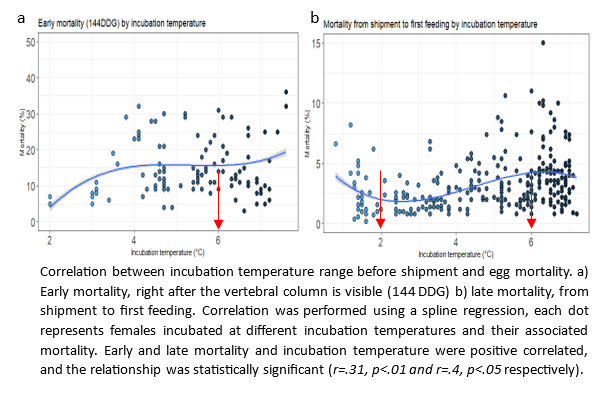ENHANCING QUALITY AND WELFARE IN ATLANTIC SALMON EGGS: A COMPREHENSIVE APPROACH TO INCUBATION STRATEGY
Abstract
The increasing global demand for high-quality Atlantic salmon ( Salmo salar) eggs calls for hatchery strategies that not only maximize survival rates but also ensure comprehensive egg welfare. This study explores critical factors in incubation, emphasizing the role of temperature in minimizing deformities, improving survival, and synchronizing hatching. Based on the analysis of over 1 billion eggs produced by Benchmark in Europe, Iceland, and Norway, we identify incubation temperature as a key determinant of developmental success.
Egg welfare was assessed across early (144 day-degrees) and late (950 day-degrees) developmental stages. Our data show that maintaining incubation temperatures between 2°C and 6°C significantly reduces mortality and the likelihood of deformities. Temperatures above 8°C or below 2°C were associated with increased risk of malformations and mortality. These findings are consistent with previous studies reporting that optimal incubation temperatures should range between 4°C and 6°C, with clear warnings against extremes below 2°C or above 12°C (Poxton , 1991; Fraser et al., 2015). Furthermore, Wargelius et al. (2005) demonstrated that elevated incubation temperatures—even without acute heat shock—can lead to gene expression changes and caudal vertebral deformities, which is corroborated by our results.
The optimal temperature range aligns with the natural spawning-to-hatching conditions of the River Vosso (2°C to 5°C), the origin of the Benchmark Genetics Iceland and Norway salmon strains (Fish, 1993; Solberg et al., 2016). This supports the biological relevance of the proposed temperature window.
Beyond survival and deformities, hatching window synchronization also proved to be a key indicator of egg quality and welfare. Incubation temperatures within the 2°C–6°C range led to tighter and more synchronized hatching windows, contributing to uniform development, better resource use, and more effective disease management protocols.
The optimal temperature range aligns with the natural spawning-to-hatching conditions of the River Vosso (2°C to 5°C), the origin of the Benchmark Genetics Iceland and Norway salmon strains (Fish, 1993; Solberg et al., 2016). This supports the biological relevance of the proposed temperature window.
Beyond survival and deformities, hatching window synchronization also proved to be a key indicator of egg quality and welfare. Incubation temperatures within the 2°C–6°C range led to tighter and more synchronized hatching windows, contributing to uniform development, better resource use, and more effective disease management protocols.
Conclusion
In conclusion, focusing on an optimal incubation temperature between 2°C and 6°C enhances egg welfare by improving survival rates, reducing deformities, and achieving synchronized hatching. These results provide a science-based framework for welfare-oriented Atlantic salmon aquaculture.
Reference
Fish, F. (1993).Timing of spawning in cultured and wild Atlantic salmon ( Salmo salar ) and brown trout ( Salmo trutta ) in the River Vosso ,Norway. 167–172.
Fraser, T. W. K., Hansen, T., Fleming, M. S., & Fjelldal, P. G. (2015). The prevalence of vertebral deformities is increased with higher egg incubation temperatures and triploidy in Atlantic salmon Salmo salar L. Journal of Fish Diseases, 38(1), 75–89. https://doi.org/10.1111/jfd.12206.
Poxton, M. G. (1991). Incubation of salmon eggs and rearing of Alevins: Natural temperature fluctuations and their influence on hatchery Requirements. Aquacultural Engineering, 10, 31–53. https://doi.org/10.1016/0144-8609(91)90009-9.
Solberg, M. F., Dyrhovden, L., Matre, I. H., & Glover, K. A. (2016). Thermal plasticity in farmed, wild and hybrid Atlantic salmon during early development: Has domestication caused divergence in low temperature tolerance? BMC Evolutionary Biology, 16(1).https://doi.org/10.1186/s12862-016-0607-2
Wargelius, A., Fjelldal, P. G., & Hansen, T. (2005). Heat shock during early somitogenesis induces caudal vertebral column defects in Atlantic salmon (Salmo salar). Development Genes and Evolution, 215(7), 350–357. https://doi.org/10.1007/s00427-005-0482-0
